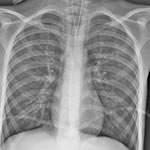Enterovirus D68 (EV-D68) is an important cause of viral lower respiratory tract illness in children.
Most people infected have mild symptoms such as runny nose, cough, sneezing, or muscle aches; some patients have fever. Often patients with more severe disease have a history of asthma or chronic lung disease.
EV-D68 infection is associated with the polio-like disease acute flaccid myelitis, and there is increasing evidence for a causal connection between the virus and this serious neurological complication.
Diagnosis is clinical. Most clinical tests for rhinovirus do not distinguish EV-D68 in the absence of specific testing.
Specific testing for EV-D68 should be considered in children with severe unexplained respiratory illness, even in the absence of fever. Although not routinely available, specific testing can be obtained on a case-by-case basis through state or local health departments, or the Centers for Disease Control and Prevention (CDC).
In patients with mild upper respiratory symptoms, the illness is typically self-limited and no specific therapy is indicated.
Patients with asthma exacerbation or severe unexplained respiratory illness should receive supportive care. Management should occur in a setting that can provide access to appropriate paediatric subspecialty and critical care support. Currently there is no specific antiviral therapy available for the treatment of any enterovirus.
Enterovirus D68 (EV-D68) is a member of the Picornaviridae family. It has emerged as an important cause of acute respiratory illness, especially in children.[1]Oermann CM, Schuster JE, Conners GP, et al. Enterovirus D68: a focused review and clinical highlights from the 2014 United States outbreak. Ann Am Thorac Soc. 2015 May;12(5):775-81.
http://www.ncbi.nlm.nih.gov/pubmed/25714788?tool=bestpractice.com
[2]Midgley CM, Jackson MA, Selvarangan R, et al. Severe respiratory illness associated with enterovirus d68 - missouri and illinois, 2014. MMWR Morb Mortal Wkly Rep. 2014 Sep 12;63(36):798-9.
http://www.cdc.gov/mmwr/preview/mmwrhtml/mm6336a4.htm
http://www.ncbi.nlm.nih.gov/pubmed/25211545?tool=bestpractice.com
[3]Foster CB, Friedman N, Carl J, et al. Enterovirus D68: a clinically important respiratory enterovirus. Cleve Clin J Med. 2015 Jan;82(1):26-31.
http://www.ccjm.org/index.php?id=107953&tx_ttnews[tt_news]=319161&cHash=311070af3357f93577156ab83fd358ec
http://www.ncbi.nlm.nih.gov/pubmed/25552624?tool=bestpractice.com
In 2014, the US experienced an outbreak, with numerous children requiring hospital admission due to severe lower respiratory illness and asthma. Further outbreaks occurred in 2016 and 2018.[4]Shah MM, Perez A, Lively JY, et al. Enterovirus D68-associated acute respiratory illness-new vaccine surveillance network, United States, July-November 2018-2020. MMWR Morb Mortal Wkly Rep. 2021 Nov 26;70(47):1623-8.
https://www.cdc.gov/mmwr/volumes/70/wr/mm7047a1.htm
http://www.ncbi.nlm.nih.gov/pubmed/34818320?tool=bestpractice.com
Mounting evidence also supports a causal role of EV-D68 for the polio-like illness acute flaccid myelitis.[5]Pastula DM, Aliabadi N, Haynes AK, et al. Acute neurologic illness of unknown etiology in children: Colorado, August - September 2014. MMWR Morb Mortal Wkly Rep. 2014 Oct 10;63(40):901-2.
http://www.cdc.gov/mmwr/preview/mmwrhtml/mm6340a5.htm
http://www.ncbi.nlm.nih.gov/pubmed/25299607?tool=bestpractice.com
[6]Greninger AL, Naccache SN, Messacar K, et al. A novel outbreak enterovirus D68 strain associated with acute flaccid myelitis cases in the USA (2012-14): a retrospective cohort study. Lancet Infect Dis. 2015 Jun;15(6):671-82.
http://www.ncbi.nlm.nih.gov/pubmed/25837569?tool=bestpractice.com
[7]Ayscue P, Haren KV, Sheriff H, et al. Acute flaccid paralysis with anterior myelitis - California, June 2012-June 2014. MMWR Morb Mortal Wkly Rep. 2014 Oct 10;63(40):903-6.
http://www.cdc.gov/mmwr/preview/mmwrhtml/mm6340a6.htm
http://www.ncbi.nlm.nih.gov/pubmed/25299608?tool=bestpractice.com
[8]Messacar K, Schreiner TL, Maloney JA, et al. A cluster of acute flaccid paralysis and cranial nerve dysfunction temporally associated with an outbreak of enterovirus D68 in children in Colorado, USA. Lancet. 2015 Apr 25;385(9978):1662-71.
http://www.ncbi.nlm.nih.gov/pubmed/25638662?tool=bestpractice.com
[9]Lu E, Sinha A, Freeman MC. Clinical progress note: enterovirus D68 and acute flaccid myelitis. J Hosp Med. 2023 May;18(5):435-8.[10]Knoester M, Helfferich J, Poelman R, et al. Twenty-nine cases of enterovirus-D68-associated acute flaccid myelitis in Europe 2016: a case series and epidemiologic overview. Pediatr Infect Dis J. 2019 Jan;38(1):16-21.
https://journals.lww.com/pidj/fulltext/2019/01000/twenty_nine_cases_of_enterovirus_d68_associated.4.aspx
http://www.ncbi.nlm.nih.gov/pubmed/30234793?tool=bestpractice.com
[11]Messacar K, Asturias EJ, Hixon AM, et al. Enterovirus D68 and acute flaccid myelitis-evaluating the evidence for causality. Lancet Infect Dis. 2018 Aug;18(8):e239-47.
https://pmc.ncbi.nlm.nih.gov/articles/PMC6778404
http://www.ncbi.nlm.nih.gov/pubmed/29482893?tool=bestpractice.com
[12]Hu Y, Musharrafieh R, Zheng M, et al. Enterovirus D68 antivirals: past, present, and future. ACS Infect Dis. 2020 Jul 10;6(7):1572-86.
https://pmc.ncbi.nlm.nih.gov/articles/PMC8055446
http://www.ncbi.nlm.nih.gov/pubmed/32352280?tool=bestpractice.com
EV-D68 is closely related to rhinoviruses. Most clinical tests for rhinovirus do not distinguish EV-D68 in the absence of strain-specific typing.[13]McAllister SC, Schleiss MR, Arbefeville S, et al. Epidemic 2014 enterovirus D68 cross-reacts with human rhinovirus on a respiratory molecular diagnostic platform. PLoS One. 2015 Mar 23;10(3):e0118529.
http://www.ncbi.nlm.nih.gov/pubmed/25799541?tool=bestpractice.com

